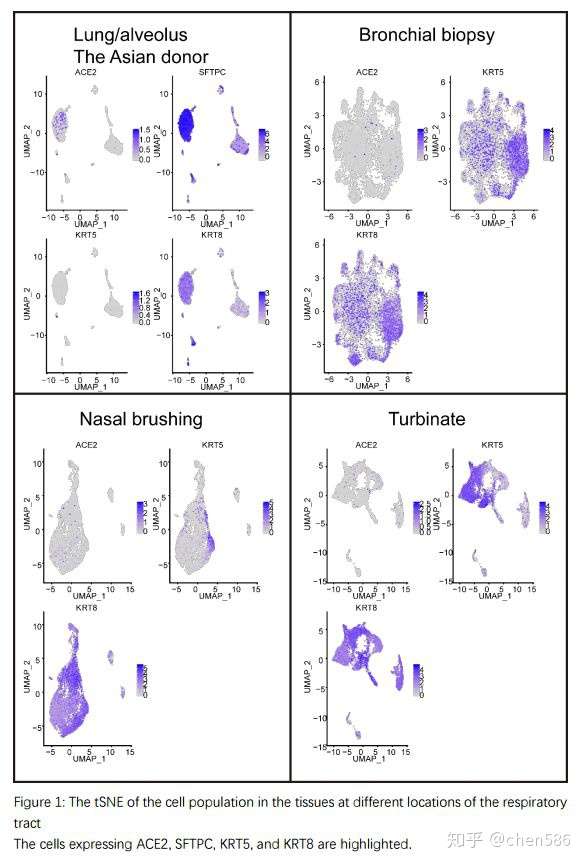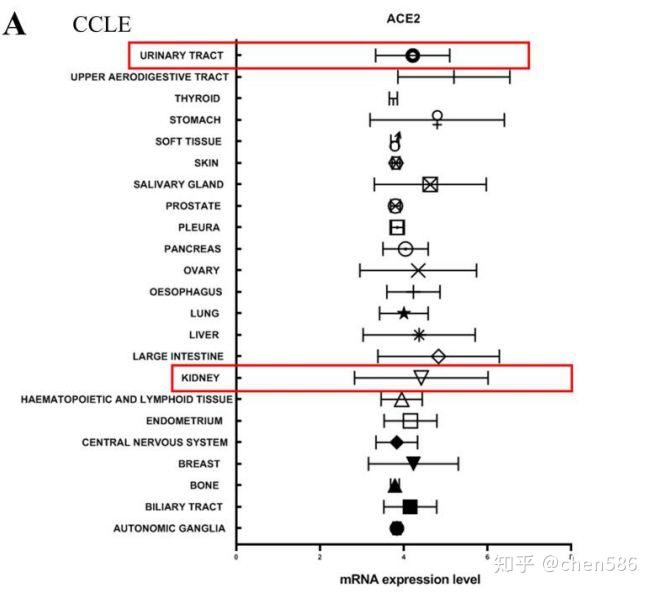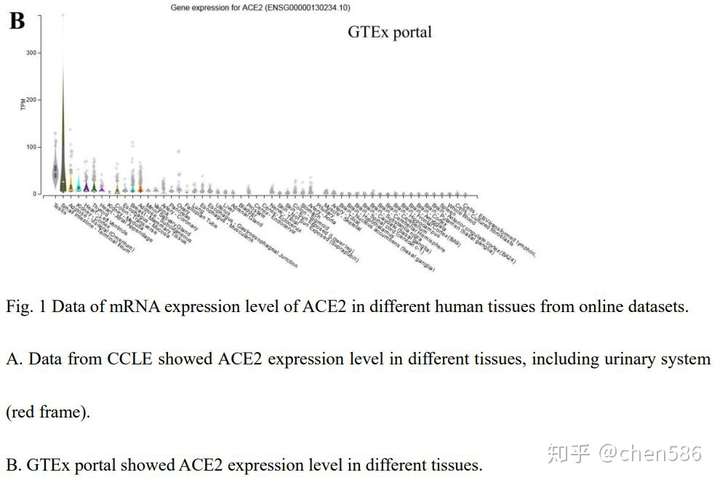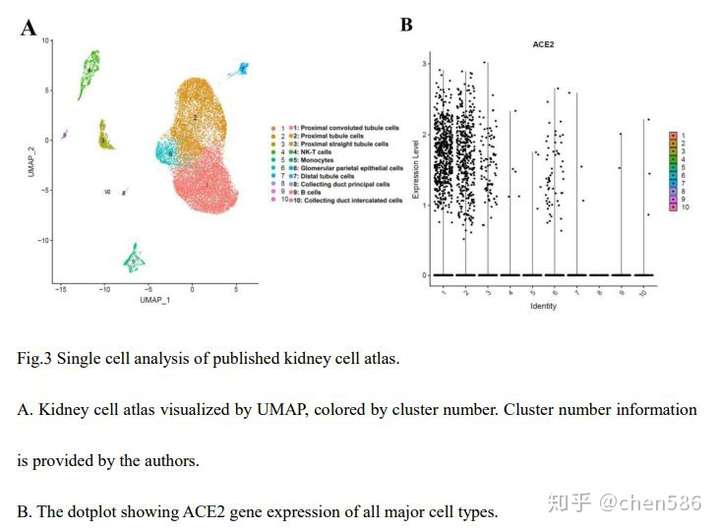博文
最新进展!单细胞数据显示ACE2在鼻腔、肾脏、睾丸均有分布!
||
继上期发表的利用单细胞公共数据对新冠受体ACE2的研究进展后,利用单细胞研究ACE2在不同组织器官中的分布如火如荼的展开,下面介绍最新发表的两篇文献。

A novel coronavirus (2019-nCoV) was first identified in Wuhan, Hubei Province, and then spreads to the other Provinces of China. WHO decides to determine a Public Health Emergency of International Concern (PHEIC) of 2019-nCoV. 2019-nCov was reported to share the same receptor, Angiotensin-converting enzyme 2 (ACE2), with SARS-Cov. Here based on the public single-cell RNA-Seq datasets, we analyzed the ACE2 RNA expression profile in the tissues at different locations of the respiratory tract. The result indicates that the ACE2 expression appears in nasal epithelial cells. We found that the size of this population of ACE2-expressing nasal epithelial cells is comparable with the size of the population of ACE2-expression type II alveolar cells (AT2) in the Asian sample reported by Yu Zhao et al. We further detected 2019-nCoV by polymerase chain reaction (PCR) from the nasal-swab and throat-swab of seven suspected cases. We found that 2019-nCoV tends to have a higher concentration in the nasal-swab comparing to the throat-swab, which could attribute to the ACE2-expressing nasal epithelial cells. We hope this study could be informative for virus-prevention strategy development, especially the treatment of nasal mucus.
2020年2月11日浙江大学医学院附属第一医院传染病诊治国家重点实验室Zheng Min团队在医学预印本medRxiv发表题为Single-cell RNA expression profiling of ACE2, the putative receptor of Wuhan 2019-nCoV, in the nasal tissue的研究内容,分析了呼吸道不同位置组织中的ACE2 RNA表达谱。结果表明ACE2在鼻上皮细胞中也表达,说明鼻腔也可能是病毒感染侵袭的重要器官。
公共数据:GSE122960
数据分析
软件:Seurat (3.1.4)
筛选:filter out the cells 1-expressing less than 200 genes; or 2-highly expressing mitochondrial genes, in which mitochondrial genes’ reads account for more than 25% of the total reads. Filter out the genes expressing in less than 3 samples.
降维聚类:默认参数
结果分析
(1)作者对亚洲捐献者通过鼻刷样品、支气管活检样品、鼻甲和肺组织进行单细胞RNA-Seq测序(Nature重磅综述 |关于RNA-seq,你想知道的都在这)。作者发现,KRT8在亚洲捐献者的鼻刷样品,支气管活检样品、鼻甲和肺组织的细胞中广泛表达(fig 1)。将KRT8作为表面细胞的标记,并将KRT5作为基底细胞的标记。然后作者将表达ACE2,KRT8,和两者都表达的细胞分别进行统计(table 1),发现在鼻刷和鼻甲样品中约有3.2%和2.1%的KRT8表达细胞同时表达ACE2。


(2)作者分别对7名患者通过聚合酶链反应(PCR)检测其鼻和咽拭子中2019-nCoV的病毒滴度,并通过循环阈值(CT)测量。我们发现两名患者(table 2中的患者W1和Z1)在其鼻拭子中检测到了2019-nCoV,但在其咽拭子中未检测到。在Z2患者中,他的鼻拭子证实为2019-nCoV。在Z4患者中,鼻拭子和咽拭子中均检测到2019-nCoV。但是,CT值比较结果表明鼻拭子中的病毒滴度高于喉咙拭子。


In December 2019 and January 2020, novel coronavirus (2019-nCoV) - infected pneumonia (NCIP) occurred in Wuhan, and has already posed a serious threat to public health. ACE2 (Angiotensin Converting Enzyme 2) has been shown to be one of the major receptors that mediate the entry of 2019-nCoV into human cells, which also happens in severe acute respiratory syndrome coronavirus (SARS). Several researches have indicated that some patients have abnormal renal function or even kidney damage in addition to injury in respiratory system, and the related mechanism is unknown. This arouses our interest in whether coronavirus infection will affect the urinary and male reproductive systems. Here in this study, we used the online datasets to analyze ACE2 expression in different human organs. The results indicate that ACE2 highly expresses in renal tubular cells, Leydig cells and cells in seminiferous ducts in testis. Therefore, virus might directly bind to such ACE2 positive cells and damage the kidney and testicular tissue of patients. Our results indicate that renal function evaluation and special care should be performed in 2019-nCoV patients during clinical work, because of the kidney damage caused by virus and antiviral drugs with certain renal toxicity. In addition, due to the potential pathogenicity of the virus to testicular tissues, clinicians should pay attention to the risk of testicular lesions in patients during hospitalization and later clinical follow-up, especially the assessment and appropriate intervention in young patients’ fertility.
2020年2月13日,南京医科大学附属苏州医院王建清研究组在预印本网站medRxiv上发表题为“ACE2 Expression in Kidney and Testis May Cause Kidney and TestisDamage After 2019-nCoV Infection”的研究内容,提示新冠病毒感染可能造成肾脏和睾丸损伤。
公共数据 :GSE131685 ,GSE107585
结果分析:
(1)作者首先发现在部分患者中出现明显的肾功能异常。作者利用公共数据集 CCLE 和 GTEx探索了ACE2在泌尿系统中的表达水平,发现肾细胞中ACE2 mRNA表达水平相对较高(图1)。


图一
(2)为了进一步确定肾细胞中ACE2的蛋白表达水平,作者利用Human Protein Atlas及免疫组织化学(IHC)发现,尽管mRNA表达水平不是很高,但肾脏中ACE2蛋白的表达水平明显更高,尤其是在肾小管细胞中(图2)。

图二
作者还发现ACE2在睾丸细胞中表达非常高。睾丸中ACE2的蛋白质和mRNA表达几乎是体内最高的。此外,生精细胞和间质细胞均显示出高ACE2表达水平。
这些结果表明睾丸细胞是2019-nCoV的潜在靶标。
(3)为了进一步评估ACE2的细胞类型特异性表达并确认肾脏中ACE2的表达水平,我们从GEO(GEO131685)数据集下载了人肾脏单细胞RNA测序的基因表达数据。作者根据原始文献中的marker进行细胞分群单细胞分群后,怎么找到Marker基因定义每一类群?(图3A),并在肾小管细胞中发现了特定的ACE2表达 。相反,在免疫细胞和肾小球上皮细胞中未观察到ACE2表达(图3B)。

图三
大总结
结合上期发表的几篇单细胞文献,现在已经揭示了许多组织中ACE2的表达,包括:
少量的肺部AT2细胞;
鼻腔中散在表达;
气管中散在表达;
在吸收性肠上皮中高表达;
少量胆管细胞中表达;
在口腔粘膜细胞中表达;
在肾小管细胞中表达;
睾丸生精细胞和间质细胞中表达;
我想再重复一下我上一期推送的观点:表达ACE2就一定容易感染吗?前几天有篇文章报出来新冠病毒与受体结合的能力是SARS的10-20倍,也说明了该次病毒侵袭之快的一个重要原因(先前文献说亲和力低于SARS)。但是否表达ACE2就一定会感染,这个问题其实是有待商榷的,只能说通过受体进行感染,但病毒生命周期中所需要的细胞元件在宿主细胞是否都存在也是需要考量的;我曾经看过一篇文献,题目我给忘啦(耍流氓,哈哈哈),里面比较经典的实验就是从中华菊头蝠中分离出的SARS-like冠状病毒,用来侵袭其他物种蝙蝠时,即使大量表达ACE2也不能在该bat中增殖感染,说明可不是仅仅看看ACE2的有无和亲和力与否那样简单。
推荐阅读
https://blog.sciencenet.cn/blog-118204-1220233.html
上一篇:蛋白质组学研究概述
下一篇:这也太简单了吧!一个函数完成数据相关性热图计算和展示